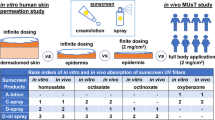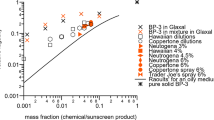Abstract
Purpose. The objectives of this study were to develop an in vitro model for studying sunscreen permeation in skin, and evaluate the influence of formulation differences.
Methods. The sunscreens studied were two of the most widely used agents, octyl methoxycinnamate (OMC) and benzophenone-3. Preparations containing radiolabeled actives were applied to micro-Yucatan pig skin dermatomed to a thickness of 250−300 μm as a finite dose in a flow-through diffusion system. At the end of each experiment the amounts removed by washing, retained inside stratum corneum (SC) and penetrated into receptor and viable skin were determined.
Results. The two sunscreens reached a peak level in SC within an hour. Benzophenone-3 penetrated skin to a greater extent than OMC. The opposite was true when comparisons of SC retention were made. The ratio of retained to penetrated amount of sunscreens from a hydroalcoholic formulation at the end of 10 hours was higher when the sunscreens were present together than alone.
Conclusions. Despite the highly lipophilic nature of sunscreens, particularly OMC, SC is the rate limiting skin layer for penetration. Penetration and SC retention were formulation dependent. The ratio of SC content to the amount penetrated is a useful tool for evaluating sunscreen permeation.
Similar content being viewed by others
REFERENCES
A. C. Watkinson, K. R. Brain, K. A. Walters, and J. Hadgraft. Prediction of the percutaneous penetration of ultra-violet filters used in sunscreen formulations. Int. J. Cosmet. Sci. 14:265–275 (1992).
D. Dupuis, A. Rougier, R. Roguet, and C. Lotte. The measurement of the SC reservoir: A simple method to predict the influence of vehicles on In-vivo percutaneous absorption. Br. J. Dermatol. 115:233–238 (1986).
C. G. J. Hayden, M. S. Roberts, and H. A. E. Benson. Systemic absorption of sunscreen after topical application. Lancet 350:863–864 (1997).
K. A. Walters, K. R. Brain, D. Howes, V. J. James, A. L. Kraus, N. M. Teetsel, M. Toulon, A. C. Watkinson, and S. D. Gettings. Percutaneous penetration of octyl salicylate from representative sunscreen formulations through human skin In vitro. Food Chem. Toxicol. 35:1219–1225 (1997).
D. Cernasov, R. Macchio, M. Meisha, F. Plakogiannis, and M. Sidhom. Octyldodecyl neopentanoate—its effects on the performance of sunscreen formulations. Cosmet. Toil. 112:75–82 (1997).
G. M. Lazar, A. Baillet, A. E. Fructus, J. Arnaud-Battandier, D. Ferrier, and J. P. Marty. Evaluation of In vitro percutaneous absorption of UV filters used in sunscreen formulations. Drug Cosmet. Ind. 158:50–62 (1996).
P. Treffel and B. Gabard. Skin penetration and sun protection factors of ultra-violet filters from two vehicles. Pharm. Res. 13:770–774 (1996).
T. Carpenter, A. Howe, A. O'Connor, J. Orfanelli, and R. Siegfried. Protection from sun protectors. Drug Cosmet. Ind. 158:56–103 (1996).
K. Sato, K. Sugibayashi, and Y. Morimoto. Species differences in percutaneous absorption of nicorandil. J. Pharm. Sci. 80:104–107 (1991).
M. Roberts and K. R. Mueller. Comparisons of In-vitro nitroglycerin flux across Yucatan pig, hairless mouse and human skins. Pharm. Res. 7:673–676 (1990).
K. R. Mueller, M. E. Roberts, and L. A. Scott. Automated In vitro method for evaluating diffusion characteristics of transdermal nitroglycerine delivery systems with or without skin. Drug Dev. Ind. Pharm. 16:1857–1880 (1990).
H. M. Fares and J. L. Zatz. Dual-probe method for assessing skin barrier integrity: Effect of storage conditions on permeability of micro-Yucatan pig skin. J. Soc. Cosmet. Chem. 48:175–186 (1997).
L. E. Agrapidis-paloympis, R. A. Nash, and N. A. Shaath. The effect of solvents on the ultraviolet absorbance of sunscreens. J. Soc. Cosmet. Chem. 38:209–221 (1987).
G. P. Kushla. Studies of lidocaine permeation through hairless mouse skin from propylene glycol-water mixtures. M.S. Thesis, Rutgers University, New Jersey (1986).
C. S. Okereke, M. S. Abdel-Rhaman, and M. A. Friedman. Disposition of benzophenone-3 after dermal administration in male rats. Toxicolol. Lett. 73:113–122 (1994).
R. J. Scheuplein. Mechanism of percutaneous absorption. J. Invest. Dermatol. 48:79–88 (1967).
Author information
Authors and Affiliations
Corresponding author
Rights and permissions
About this article
Cite this article
Gupta, V.K., Zatz, J.L. & Rerek, M. Percutaneous Absorption of Sunscreens Through Micro-Yucatan Pig Skin In Vitro. Pharm Res 16, 1602–1607 (1999). https://doi.org/10.1023/A:1018916907263
Issue Date:
DOI: https://doi.org/10.1023/A:1018916907263




